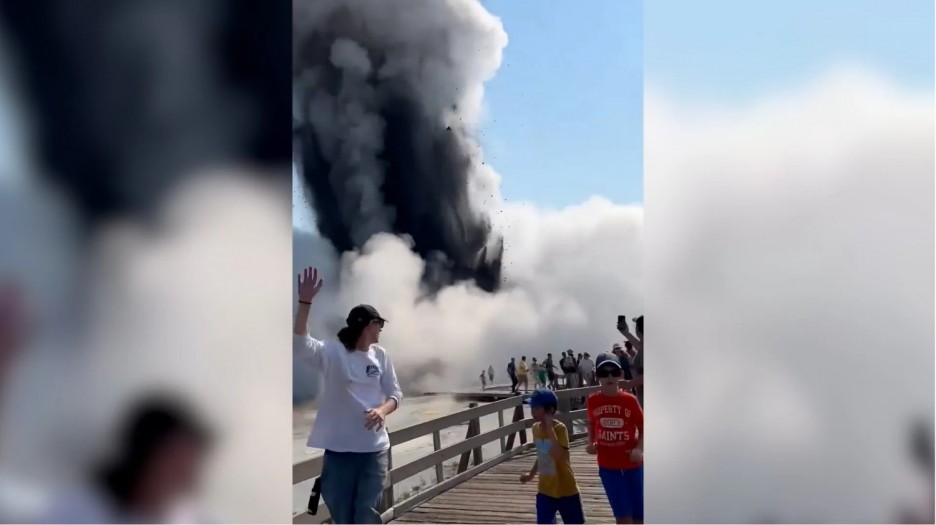Yellowstone's Sudden Hydrothermal Explosion Cause Revealed
After a boiling hot geyser — an extremely rare kind of hot spring that erupts under pressure — suddenly hurled scalding water and debris high into the air in Yellowstone National Park, the cause of the explosion has been revealed.

The explosion happened at approximately 10a.m. on Tuesday near the Black Diamond Pool in the Biscuit Basin, located a few miles northwest of the renowned Old Faithful geyser.
The blast, which caused damage to the boardwalk, was captured by visitors who shared footage of the eruption and its aftermath online.
RELATED: Two D.C. Women Who Allegedly Killed Their 'Sugar Daddy' And Cut Off His Thumb
Mike Poland, a scientist with the Yellowstone Volcano Observatory, detailed in a joint statement from Yellowstone National Park and the U.S. Geological Survey, said "there were no reports of injury. The explosion appears to have originated near Black Diamond Pool."
The explosion was caused by a hydrothermal event, characterized by the explosive release of boiling water, steam, and mud. This type of explosion happens when extremely hot water, stored in underground reservoirs, encounters hot rock or magma. The intense heat turns the water into steam quickly, causing pressure to build until it surpasses the strength of the surrounding rock or soil, resulting in a violent eruption.
Hydrothermal explosions vary widely in scale, from minor geyser-like bursts to massive eruptions that create craters and scatter rocks and debris over large areas, according to the USGS.
Aerial image shows location of this morning's hydrothermal explosion in #Yellowstone's #BiscuitBasin. Light gray area shows how far mud & rocks were hurled. While explosion was near the boardwalk & visitors were present, no injuries were reported. NPS photo taken Jul 23, 2024. pic.twitter.com/O5T4YLUEiA
— USGS Volcanoes🌋 (@USGSVolcanoes) July 23, 2024
Smaller hydrothermal eruptions are relatively frequent in Yellowstone. A minor explosion took place in the Norris Geyser Basin on April 15, and a comparable event was observed in Biscuit Basin in 2009.
Yellowstone has a history of notable hydrothermal explosions. One of the most significant events occurred around 13,800 years ago at Mary Bay, located on the edge of Yellowstone Lake, where a massive explosion formed a crater spanning over 2 miles in diameter.
"Based on the occurrence of large hydrothermal explosion events over the past 16,000 years, an explosion large enough to create a 100-meter (328-foot) wide crater might be expected every few hundred years," the USGS stated.
A video captured by California real estate agent Vlada March depicted a massive dark gray column of steam and dust shooting into the sky from this week's explosion. The footage also shows people on the nearby boardwalk fleeing as hot steam surged upward and rock fragments fell to the ground. March also shared another video showcasing the aftermath.
Hydrothermal explosions differ from volcanic eruptions because they are caused by the interaction of water and heat, not by magma moving towards the surface.
"Monitoring data show no changes in the Yellowstone region. Today's explosion does not reflect activity within volcanic system, which remains at normal background levels of activity. Hydrothermal explosions like that of today are not a sign of impending volcanic eruptions, and they are not caused by magma rising towards the surface," Poland stated in the announcement.
#Yellowstone Park staff are on scene assessing conditions after a small hydrothermal explosion occurred today (July 23) in #BiscuitBasin. There are no reports of injuries. The boardwalk, on the other hand, will need a few repairs. The area remains temporarily closed. NPS photos. pic.twitter.com/XrHuUhw7fk
— USGS Volcanoes🌋 (@USGSVolcanoes) July 23, 2024
The area has been temporarily closed to the public.






